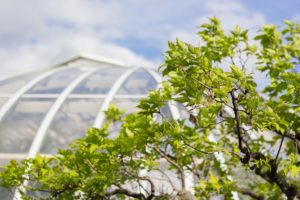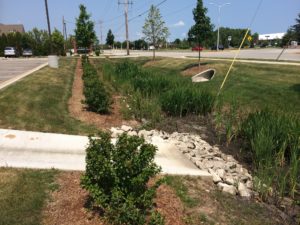Say you have an indoor cannabis grow and 40 percent of your utility costs go to lighting. You replace your HID (high-intensity discharge) bulbs with LEDs. To make the math easy, let’s say conservatively that you save 25 percent on lighting costs and the effect on yields is neutral. Cutting your lighting costs by a quarter reduces your overall utility costs by 10 percent, right?
Wrong. The math* is right, but the reasoning is not. LEDs generate less heat than HID bulbs, which saves you money not only on lighting but on air conditioning. That, in turn, makes it easier to minimize temperature fluctuations, reducing the strain on dehumidifiers and other systems.
- * (25% savings x 40% of total utilities = 10% overall savings)
Systems thinking
The big idea behind this, and one that’s all too often ignored in evaluating capital investment decisions across all business sectors, is systems thinking.
Systems thinking, a design approach that arose in the mid-20th century, is all about looking at how individual elements of a system act upon one another. Seemingly disconnected things have a way of complimenting or hampering each other’s performance. In an office environment, for instance, window placement will influence the light quality, increasing or decreasing reliance on artificial light. This influences utility bills and, more importantly, employee productivity. (There’s a clear link between access to daylight in the office and productivity.)
HVAC systems, insulation, fenestration (window placement), decor, employee absenteeism and turnover, indoor air quality, and microbial activity are all related. You shouldn’t look at any of them in isolation. This is true of our homes, offices, schools, communities, and yes, grow houses.
 “Systems thinking realizes that nothing ever occurs in a vacuum,” states The Green Studio Handbook. “Every element and event is seen as being a part of, and interacting with, a larger system, and that system, in turn, is part of an even larger system of interactions.” (The Handbook is about eco-friendly, functional building design and has nothing specifically to do with cannabis.)
“Systems thinking realizes that nothing ever occurs in a vacuum,” states The Green Studio Handbook. “Every element and event is seen as being a part of, and interacting with, a larger system, and that system, in turn, is part of an even larger system of interactions.” (The Handbook is about eco-friendly, functional building design and has nothing specifically to do with cannabis.)
When you view individual problems and solutions as part of a whole, you recognize they tend to have a cascading effect. As a cannabis operator, systems thinking can reveal opportunities to save money and reduce your environmental impact without sacrificing yields.
Case in point: LEDs
“LEDs have caught up (to other lighting systems) in what they can do for the plant,” recently stated Jess Peters, Oregon Cannabis Association board member and co-founder of Eco Firma Farms, in Marijuana Business Magazine.
Peters has seen LED lights outperform HIDs in terms of terpene production and yield per cubic foot. LEDs also last longer than HIDs, helping growers recoup additional up-front costs.
In fact, rebates for energy upgrades provided by utilities such as Xcel Energy in Colorado abound. So up-front costs may be nominal.
 LED lights haven’t always offered the ideal light spectrum for growing cannabis, but the technology has advanced a lot in the last two years. With the possible exception of vegetative lights, LEDs should affordably meet all your needs. At least anecdotally, they’ve been shown to improve yields. (We also touched on this subject last October in an interview with John Torkelson, Senior Operations Manager at Point Seven Group.)
LED lights haven’t always offered the ideal light spectrum for growing cannabis, but the technology has advanced a lot in the last two years. With the possible exception of vegetative lights, LEDs should affordably meet all your needs. At least anecdotally, they’ve been shown to improve yields. (We also touched on this subject last October in an interview with John Torkelson, Senior Operations Manager at Point Seven Group.)
Indoor vs. outdoor grows
Cannabis consultant Van McConnon, in a recent interview with Marijuana Business Magazine, rather bluntly suggested indoor growing isn’t economically viable in the long run.
“The indoor facilities are the noose that’s going to hang these businesses. My advice to every client I talk to is, ‘Do not spend another dollar on indoor grows. Period. Do you want to save money indoors? Don’t build it.”
While regulations around greenhouse and hoop house growing vary from one locality to the next, and a large, existing indoor growing infrastructure is already in place, the industry seems to be heading in the direction of outdoor growing by default. We’re not telling you how to grow, just talking about a potential opportunity.
Last month, Peters advised growers in a separate interview, “Get out of the municipal [water] system if you can. This is an unnecessary expense.”
A septic system and bioswales provide an alternative to those able to manage it, notes Peters. (The Green Studio Handbook defines bioswale as “densely vegetated open channels designed to attenuate and treat stormwater runoff,” although the definition clearly extends to agricultural and industrial runoff. It’s a simple, under-utilized approach to environmental mitigation.)

Recognizing that some cultivators are practically married (by necessity) to their water utilities, Peters offers some practical advice such as purpose-built water filtration solutions and recapturing water coming off dehumidifiers.
A values call, or a hard-nosed business decision?
Marijuana Business Magazine also reported in January that “[I]nvesting in environmental improvements and efficiencies—even beyond those required by law—may mean the difference between success and failure in these days of razor-thin wholesale margins among growers.” Increasingly strict environmental requirements are being imposed on the industry. Waste reduction, water and energy conservation are higher priorities than they were five years ago due to a combination of shrinking margins and regulatory mandates. Radical resource efficiency is less and less a values call, and more and more a hard-nosed business decision.
Not surprisingly, Boulder, CO has the most stringent environmental regs in the state if not nationwide. The city now requires cultivators to report energy use and offset it by paying into the new Energy Impact Offset Fund. Boulder created the fund specifically to address the cannabis industry’s energy footprint.
Regardless of whether you operate in a locality with strict environmental regulations, controlling costs is the other side of the sustainability coin. Investing in better lighting and water recovery processes may seem like a tough call if your margins are being squeezed. But working with your local utility may improve the financial appeal of making investments in resource efficiency.
Being as green as your product would be a pretty big undertaking, but it has been managed.
Later this spring we’ll circle back to this topic, highlighting 5 – 7 companies that have developed exciting innovations in water conservation and eco-friendly lighting technologies.
Cannabis Enterprise Business Solutions
Talk to one of our reps to learn how our industry-leading point of sale and inventory management solutions can help keep your dispensary sprouting upward.
1-800-417-3030



